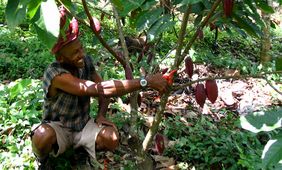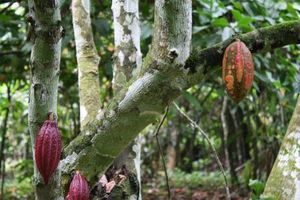
Ghana is the second-largest producer of cocoa in the world and in recent years has emerged as the world’s principal supplier of Fairtrade-certified cocoa — about 6% of national production falls under that scheme. Multisector collaboration is needed to address persistent challenges and to support Ghana’s overall move to a sustainable cocoa sector.
The world’s favorite treat has never been more popular. In the past decade, the chocolate industry’s demand for cocoa has increased by 12% and production has barely been able to keep pace. Growing demand, particularly from emerging economies like China and India, is good news for the industry.
At the same time, about 6 million cocoa producers — more than 90% of them smallholders — face significant challenges: low productivity, poverty in the producing communities, and limited infrastructure to connect producers with buyers. Improved and diverse planting stock that can resist pest and diseases, thrive in poor soils and grow in changing climatic conditions is in short supply.
With an annual production of about 750,000 to 1 million tons, Ghana is the second-largest producer of cocoa in the world. In recent years, Ghana has also emerged as the world’s principal supplier of Fairtrade-certified cocoa, with about 6% of national production falling under that scheme.
Yet a new report carried out for Fairtrade Africa by the World Agroforestry Centre (ICRAF) and Bioversity International, supported by the CGIAR Research Program on Forests, Trees and Agroforestry (FTA), concludes that monetary benefits derived from Fairtrade cocoa remain low, contributing on average an additional 2% of cocoa income for certified farmers. At the same time, cooperatives use part of the Fairtrade Premium to provide their members with farming inputs and training, and to fund overall community development.
Read more: Fairtrade cocoa in Ghana: taking stock and looking ahead

This relates to the fact that only part of the Fairtrade Premium of US$200 per ton is channeled through the cooperatives to the producers as a cash bonus (16 to 65% of the premium), while the remainder is given as farming inputs like fertilizers, agrochemicals and planting materials (up to 38%), or allocated to fund trainings, cooperative administration, and certification fees (20 to 84%) and overall community development (up to 15%).
One way that voluntary standards like Fairtrade try to empower producers is through the creation of new business organizations such as rural cooperatives. These efforts can go hand-in-hand with those of the cocoa industry, which supports farmers in rejuvenating their aging cocoa plantations.
For the cocoa sector to become sustainable, it will also be critical to attract younger farmers to become cacao producers, empowering them to generate enough income to sustain their families and communities. Rural cooperatives can support this aim but, as the report points out, increased membership of these organizations is only sustainable if sales under Fairtrade terms grow at least at the same rate, which is currently not happening.
The report also points at the importance of diversified production systems, allowing the farmers to be less reliant on cocoa as a principal source of income. Cacao can be planted together with other crops, in particular fruit and timber trees that provide shade for the young cacao saplings and help improve nutrition and income.

Such diversification makes for more resilient production and livelihood systems. For example, a study* of the relationship between cocoa cultivation and the conservation of biological diversity found that “cacao farms with diverse shade have the potential to support greater local diversity and act as a more effective refuge for some tropical forest organisms than alternative lowland tropical crops, particularly annual crops and cattle pasture.”
The third main finding was that Fairtrade farmers have improved access to training compared to non-members — 99% of cooperative members reported having received training on good agricultural practices, such as pruning and replanting, versus 51% of non-members.
Still, average productivity on Fairtrade-certified farms is within the range of the national average and additional efforts are needed to increase cacao productivity.
Read also: Sweeter deals: Prospects for expanding Fairtrade cocoa in Ghana
Dietmar Stoian from Bioversity International, one of the authors of the study added: “This study provides Fairtrade International, the four recently Fairtrade-certified cocoa cooperatives sampled, and other stakeholders in Ghana’s cocoa sector with a baseline for future impact assessments. The indicators developed for household- and cooperative-level measurements point at potential areas of impact and allow for continuous improvement.”
“In a follow-up study in Ghana, we are now taking a broader look at the country’s move toward a sustainable cocoa sector by identifying the actual and potential role of impact investment, social lending and other responsible finance schemes and their interactions with diverse certification systems to ensure environmental and social impact in addition to financial returns.”
The report was well received by Fairtrade International, and their management’s response concludes that: “We recognize that the coops have many support needs and we agree that key challenges include growing sales, increasing cocoa productivity, supporting agricultural diversification, and strengthening of cooperatives to be able to achieve greater member engagement and gender equality.”
As a result of this study, Fairtrade International will be reviewing the Fairtrade Premium.
Originally published on the website of Bioversity International.
The report Baseline for Assessing the Impact of Fairtrade Certification on Cocoa Farmers and Cooperatives in Ghana, jointly elaborated by the World Agroforestry Centre and Bioversity International, is based on data gathered from 422 households belonging to four Fairtrade-certified cooperative unions, and 80 households from non-certified cooperatives. Data was collected based on indicators from Fairtrade’s Theory of Change and the 5Capitals methodology for assessing the poverty impacts of value chain development developed by the Tropical Agricultural Research and Higher Education Center (CATIE), the World Agroforestry Centre and Bioversity International.
This research is part of the CGIAR Research Programs on Forests, Trees and Agroforestry (FTA) and Policies, Institutions and Markets (PIM) and is supported by CGIAR Fund Donors. We thank Transfair Germany and Fairtrade International for funding the project and the donors who support FTA and PIM through their contributions to the CGIAR Funds. We extend our gratitude to reviewers from Fairtrade International, the Fairtrade Foundation, Fairtrade Africa and Transfair Germany. We also appreciate the willingness of representatives of Cooperative Unions and Licensed Buying Companies COCOBOD, who generously shared their insights and experiences.
*Rice, R.A. and Greenberg, R., 2000. Cacao cultivation and the conservation of biological diversity. AMBIO: A Journal of the Human Environment 29 (3): 167-173.











